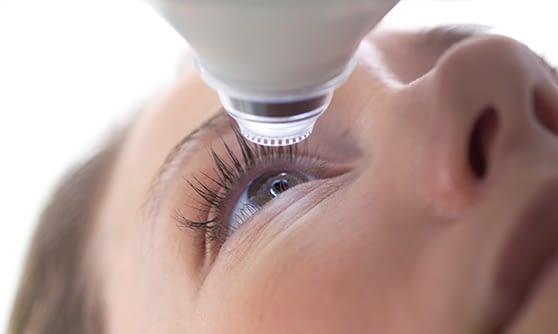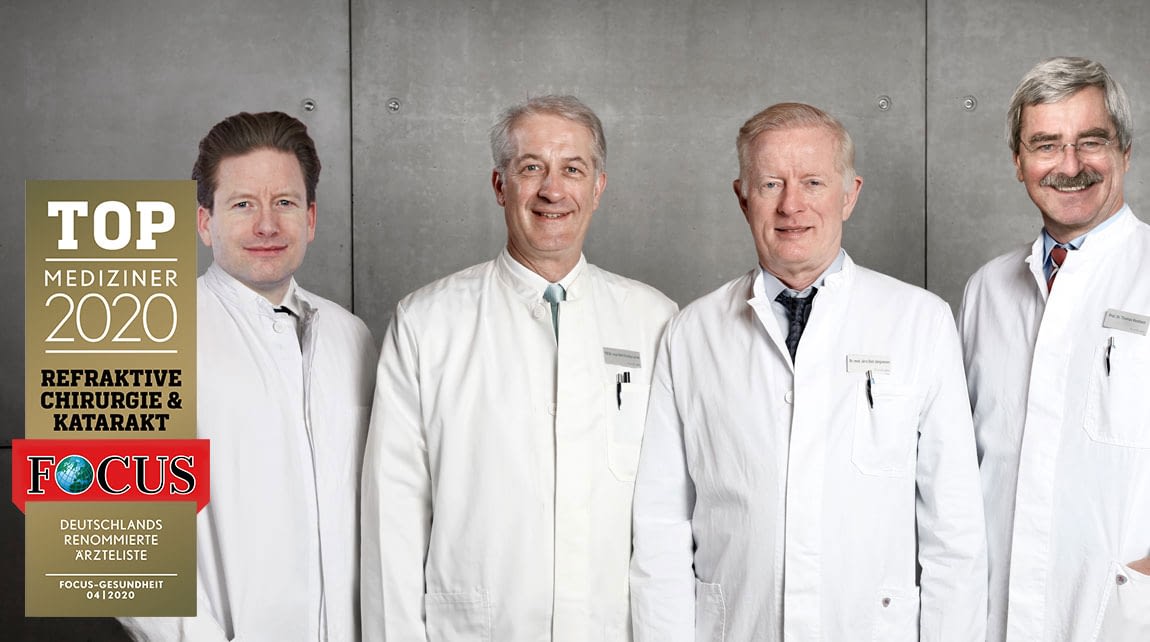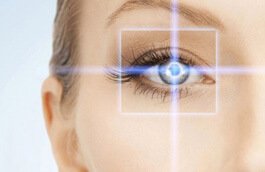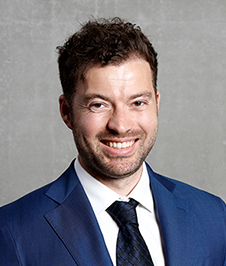LASER EYE TREATMENT VS. CONTACT LENSES - WHICH IS SAFER IN THE LONG TERM AND IS REALLY WORTH IT?
Anyone with ametropia who does not want to wear glasses can choose between contact lenses and permanent correction of poor eyesight. But which is the best and, above all, the safest method for your eyes? We have dealt with the topic and present you contact lenses and eye laser treatment in comparison.

WHAT TYPES OF CONTACT LENSES ARE THERE?
In general, there are hard and soft contact lenses as daily, weekly, monthly and annual lenses. Hard lenses are dimensionally stable and safer than soft ones, as soft lenses restrict the oxygen and nutrient supply to the cornea via the tear fluid. Soft contact lenses, on the other hand, are less noticeable and it is often easier to get used to them. So-called bifocal lenses are also available for varifocals with simultaneous near and far vision. In addition, special lenses with and without prescription are offered in different eye colors or with motifs and effects. However, effect lenses are not suitable for traffic due to the restricted field of view.
Contact lens disadvantages: risks and side effects
Since contact lenses are placed directly on the eye, there is a relatively high risk of complications. Wearing contact lenses can therefore cause numerous health problems for the eye. For example, people with misaligned eyelids, illnesses and functional disorders are generally not allowed to wear contact lenses. In the case of allergy sufferers with eyes that are prone to tears or itchy eyes, the lenses can shift, fall out or cause irritation due to friction, which can more easily lead to inflammation. In addition, the cleaning and care products as well as the material of the soft lenses can provoke allergic reactions.
If contact lenses are worn for too long, permanent damage to the eye can result, as the lenses obstruct the oxygen supply to the eye and thus lead to a lack of oxygen (hypoxia). Working for a long time at the screen and dry air, for example, can damage the lenses, even if they are worn for a short time, as they dry out the tear film and the lenses literally stick to the eye. As a result, smaller painful lesions can repeatedly arise, which favor the penetration and multiplication of fungal spores, viruses, germs and bacteria.
The eyes can also be irritated and injured when inserting and removing the lenses and pathogens can penetrate due to poor hand hygiene. Improper cleaning and care of the contact lenses often lead to problems. The resulting contamination of the contact lenses can cause irritation, inflammation and bacterial infections that can affect the cornea or conjunctiva. If left untreated, such an infection can lead to permanent damage.

LASER EYE TREATMENT AS A PERMANENT ALTERNATIVE
In a laser eye surgery is an outpatient and minimally invasive procedure that corrects the refractive error in the long run and makes wearing contact lenses unnecessary. Most of our patients are amazed at how quickly the procedure is over and that they could hardly feel any of it. An eye bandage is not necessary, only sunglasses are recommended. Clear vision is possible just a few hours after the procedure.
Possible risks of laser eye surgery
The risks of the procedure can be a slight dryness of the eyes as well as an increased sensitivity to light and glare. The side effects that can occur with laser eye surgery are usually only short-term, harmless and treatable until full recovery.
Laser eye surgery is one of the safest procedures with a chance of complications of less than 1%. In order to significantly reduce the risk of laser eye complications even further, you should only place yourself in the hands of top ophthalmologists with a high number of operations (high volume surgeons) who have been performing these operations for many years and with the most modern equipment.
At EuroEyes we can look back on more than 25 years of experience. Each of our top surgeons performs at least 1,000 operations annually, which makes a total of around 20,000 operations per year in the EuroEyes eye centers. It is not without reason that our team of doctors is continuously on the list of “FOCUS top doctors” – we at EuroEyes take our responsibility very seriously and stand for the highest quality standards.

Which eye laser methods are there?
For the permanent correction of nearsightedness (myopia), farsightedness (hyperopia) or astigmatism, there are currently the following laser treatment methods that are carried out on patients under 45 years of age: LASIK (is hardly used anymore because there are modern developments), femto- LASIK , the No-Touch-Trans-PRK and the newest and most innovative process ReLEx SMILE . The prerequisite for all procedures is that the ametropia has not changed by more than about 0.5 diopters in the last 2 years.
All EuroEyes laser treatments are preceded by a non-binding personal consultation as well as a comprehensive preliminary examination and wavefront analysis, with which a three-dimensional map of your eye is created, which is used to determine the visual impairment to be corrected. After the treatment, there will of course be medical follow-up checks every day, week and month.
ICL – The ideal procedure for people with high ametropia and thin corneas
If an eye laser treatment is not possible due to a very high ametropia or a too thin cornea, the implantation of intraocular contact lenses, or ICL lenses for short, is also an excellent solution for the permanent correction of poor eyesight.
The ICL is a clear and extremely soft plastic lens that resembles a contact lens. This plastic lens is inserted into the back chamber of the eye between the iris and your own eye lens. It remains there permanently and is neither visible nor noticeable. The operation is a routine procedure that is performed on an outpatient basis and only takes about four minutes per eye.
Find out more about lens surgery as an alternative to laser treatment. We have prepared all the relevant information for you.
THE RISKS OF CONTACT LENSES AND LASER EYE SURGERY IN COMPARISON
Despite the numerous disadvantages of contact lenses, many people still shy away from surgery on the eye, although various studies have now shown that laser eye treatment is safer in the long term.
Previously, it was believed that refractive surgery posed a higher risk than wearing contact lenses. This is not an easy comparison, since complications of contact lenses only appear after years of wearing, while most postoperative complications of laser eye treatment (e.g. slight dryness of the eyes and increased sensitivity to light) show up immediately after the procedure.
Prof. Dr. Mathers of Oregon Health & Science University, comparing data from different studies, found that contact lens wearers are at higher risk of permanent vision deterioration than patients who have had laser eye surgery. The results of the study (read here) show that the risk of a contact lens wearer is 1: 100 of developing a bacterial infection (bacterial keratitis) of the cornea in the course of their life. A bacterial infection of the cornea can lead to permanent visual impairment and, in the worst case, even to vision loss of the affected eye.
In order to assess the risk of vision deterioration after laser eye surgery, Prof. Dr. Mathers goes back to the results of over 32,000 operated US soldiers. The risk of seeing 10% worse than before after laser surgery is 1: 1,025.
From this study and our many years of experience, it can be concluded that you run a far higher risk of complications by long-term wear of contact lenses than is the case with the decision for a single laser eye treatment.
THE COST FACTOR - WHICH IS MORE EXPENSIVE: CONTACT LENSES OR LASER EYE SURGERY?
In addition to the question of the safety and possible complications of contact lenses and laser treatments, the cost is certainly also a relevant factor when weighing up which of the two options you are considering for the correction of your ametropia.
The prices of contact lenses (as of 2021) vary depending on the version between 175 euros for annual lenses with care products and 285 euros for daily lenses per year. Lifelong wearing of contact lenses can lead to costs of up to 18,000 euros. In comparison, laser eye treatments at EuroEyes are cheaper: for example, laser treatment in both eyes costs between 3,500 and 3,900 euros with Femto-LASIK and around 4,800 euros with the RELAX-SMILE method.
The costs for lifelong wear of contact lenses are on average more than twice as high compared to eye laser surgery.
Further advantages for a life without contact lenses
- Independence: If contact lenses are worn for too long or are poorly tolerated, eyelid inflammation can occur
- No more problems for allergy sufferers: Contact lenses are not suitable for hay fever or allergies, as the conjunctiva in the eye is already irritated or inflamed. Wearing contact lenses can cause infections in the eye and leave permanent damage. In addition, a pollen allergy often requires the instillation of eye drops, which contact lenses are a hindrance.
- Safety factor: laborious handling of the lenses – some people find it difficult or even afraid to use the contact lenses. In addition, correct handling is particularly important so that the eye is not injured.
- More time: Contact lenses require regular and careful cleaning and disinfection.
- Cost factor: Additional costs for care products and the regular replacement of contact lenses. Only careful hygiene will reduce the risk of eye infections. This also includes regular follow-up checks by the optician or eye doctor.
- No more dry eyes: Contact lenses cause or intensify dry eyes. Dry heating air or many hours in front of the screen can quickly damage lens wearers and cause discomfort.
CONCLUSION
If you do not want to wear glasses and are therefore dependent on wearing contact lenses in the long term, it is worthwhile to consider laser treatment of the eyes. Because: the risks of a one-time procedure are significantly lower compared to years of wearing contact lenses and the lifelong costs for contact lenses and accessories are on average more than twice as high as is the case with laser eye treatment. In addition, the permanent correction of your ametropia offers you a new attitude towards life, since from this point on you will no longer be dependent on any visual aids.
Even severe ametropia – whether nearsightedness,
farsightedness, presbyopia or astigmatism – can be corrected at EuroEyes thanks to the latest laser technology. When you get treatment at EuroEyes, you not only invest in a new attitude towards life (never again glasses or contact lenses), but also in quality, competence, precision and safety.
About EuroEyes
The EuroEyes Clinic Group is a globally successful company that was founded over 25 years ago in Hamburg and has its headquarters there to this day. In addition to locations throughout Germany, EuroEyes is also represented in China and Denmark. The clinic offers patients the entire spectrum of refractive surgery for the correction of ametropia. With the most modern eye laser and lens surgery procedures EuroEyes treats over 25,000 patients with myopia or farsightedness, astigmatism,
presbyopia or cataracts every year . The interventions enable the start of a life free of glasses and contact lenses without impairment of vision and quality of vision.
Are you also interested in a treatment at EuroEyes or would you like to find out more about us? Then please contact our service center or fill in our contact form. We look forward to seeing you!
Contact form (click here)
+49 40 348 09 29 0 – service center in Germany (English, German and Chinese)
Monday to Friday: 08:00 – 19:00
Saturday: 09:00 – 14:00

Sources: Stiftung Warentest, professional association of ophthalmologists in Germany.


















Join our Newsletter